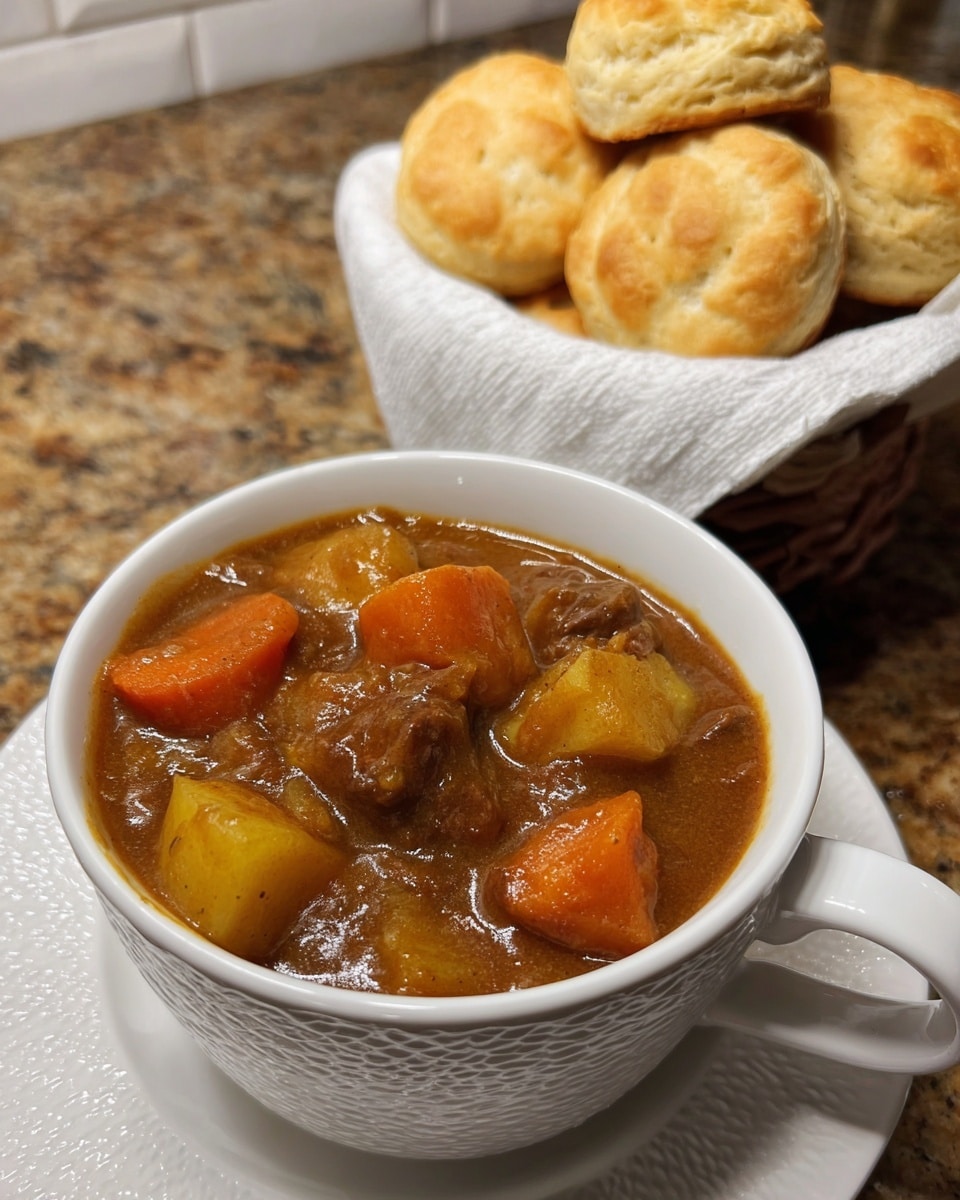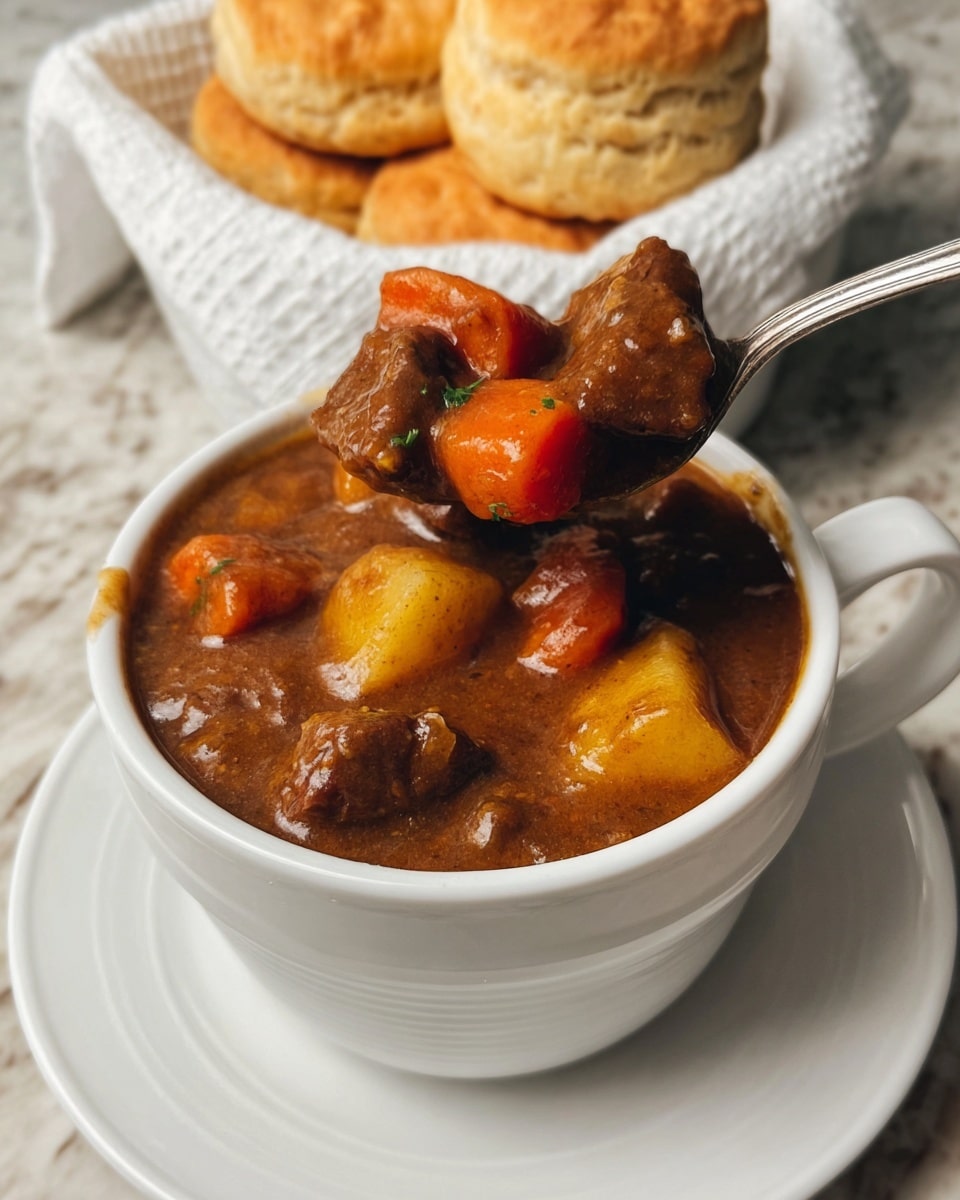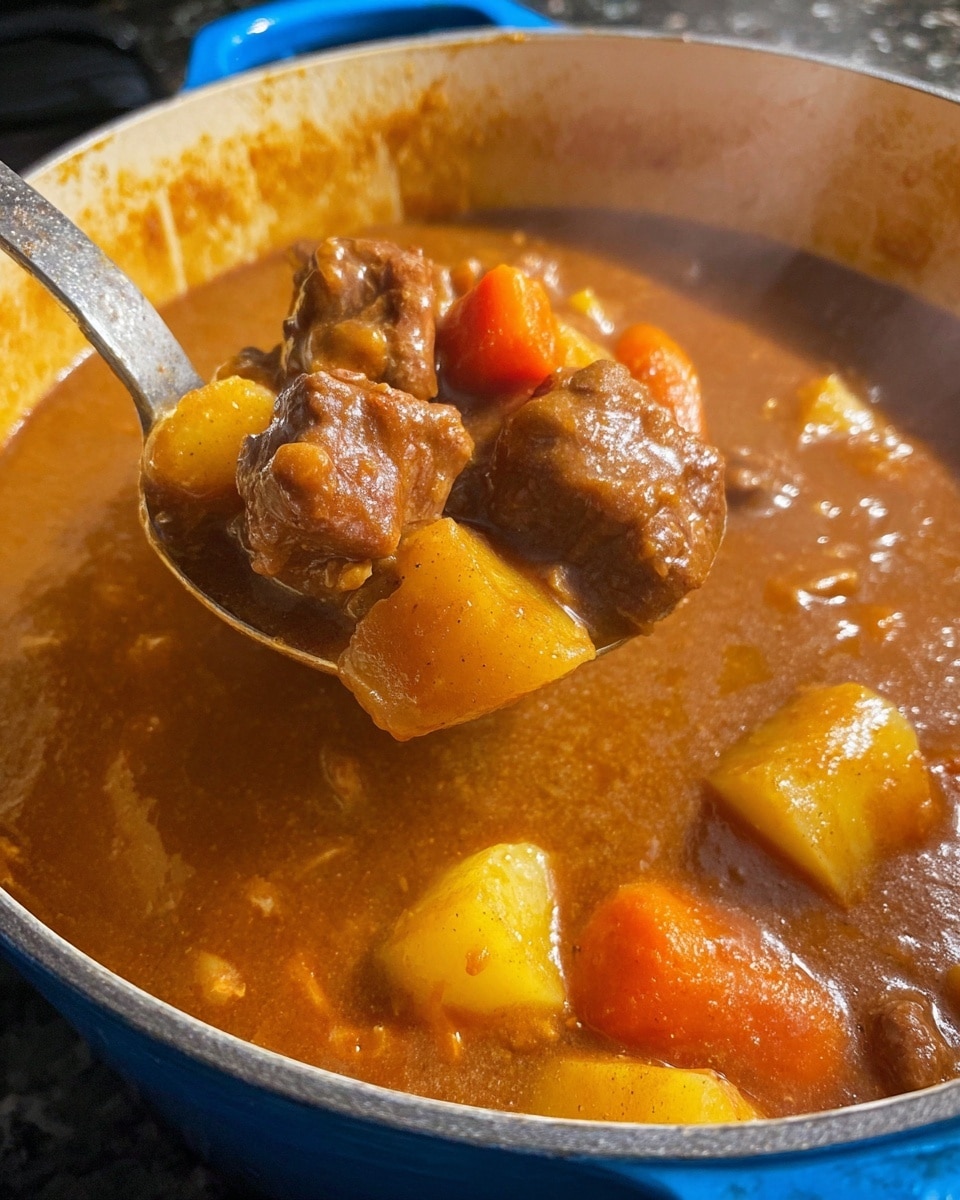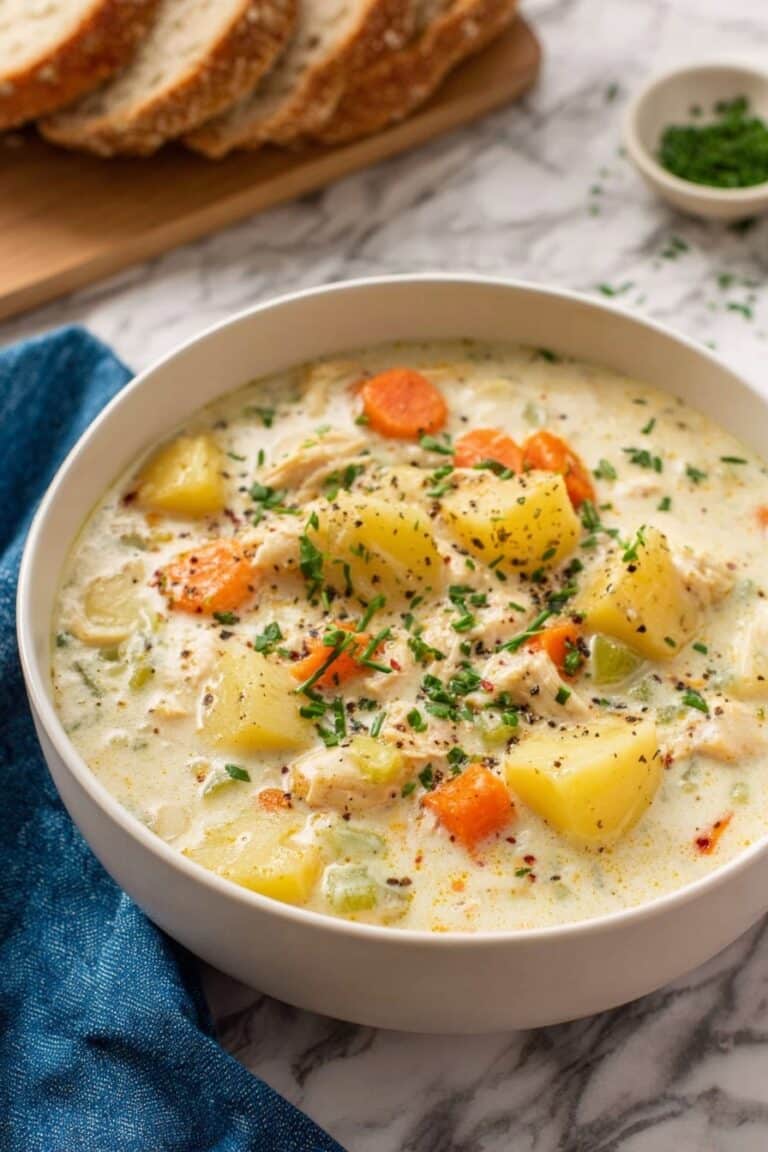Hearty Beef Stew Recipe
If you’re craving something warm, comforting, and downright satisfying, this hearty beef stew recipe is exactly what you need. It’s one of those dishes that feels like a big cozy hug in a bowl—perfect for chilly evenings or whenever you want to feel cared for through food. The rich broth, tender meat, and wholesome veggies come together in such a delicious way that it quickly became one of my go-to recipes whenever I need a meal that’s both nourishing and packed with flavor.
What I really love about this hearty beef stew recipe is how approachable it is. You don’t need fancy ingredients or complicated steps, just some patience and a little love to bring out those deep, comforting flavors. Plus, this stew works wonderfully as a make-ahead meal, so you can have dinner ready on busy nights or impress guests with minimal effort. Trust me, once you try it, you’ll want to make it again and again!
Why This Recipe Works
- Rich Flavor Development: Browning the beef and caramelizing the tomato paste creates deep, savory notes that make the stew irresistible.
- Perfect Texture Balance: The long simmering turns stew meat tender while keeping vegetables soft but not mushy.
- Simple, Quality Ingredients: Using basic pantry staples means this hearty beef stew is accessible and reliable any time of year.
- Customizable Thickness: The cornstarch slurry allows you to easily adjust the stew’s consistency to your preference.
Ingredients & Why They Work
Each ingredient in this hearty beef stew recipe plays an important role, from building layers of flavor to creating the ideal texture. I love how they come together with simple seasoning and pantry basics, and how small tweaks can really make a difference.
- Stew Meat: I recommend chuck or round cuts because they’re flavorful and become wonderfully tender with slow cooking.
- All Purpose Flour: Coating the meat in seasoned flour helps thicken the stew and gives the beef a nice crust during searing.
- Garlic Powder and Onion Powder: These boost the savory background notes without overpowering the dish.
- Salt and Pepper: Essential for seasoning every layer of the stew, so taste along the way.
- Vegetable Oil: Use a neutral oil with a high smoke point for browning the meat.
- Yellow Onion: Adds sweetness and depth when sautéed, forming a fragrant base.
- Celery: Brings a subtle freshness and texture contrast.
- Garlic Cloves: Fresh garlic perks up the whole stew with a bold aromatic kick.
- Tomato Paste: Cooking this intensifies its umami character and balances acidity, giving the broth richness.
- Beef Broth: The foundation of the stew’s body that adds warmth and hearty flavor.
- Worcestershire Sauce: A secret ingredient that adds complexity and a slightly tangy depth.
- Herbs De Provence: This blend of herbs gives a subtle herbal lift without overwhelming the meat and veggies.
- Carrots: Sweet and tender, carrots provide color and a naturally sweet element.
- Yukon Gold Potatoes: I love Yukon Golds for their creamy, buttery texture—the perfect stew potato that holds its shape.
- Bay Leaves: They lend a cozy, slightly floral aroma that completes the stew’s flavor profile.
- Cornstarch and Cold Water: This slurry is your go-to for thickening the stew just the way you like it.
Tweak to Your Taste
I always encourage you to make this hearty beef stew recipe truly your own. Over time, I’ve experimented with a few variations based on what I have in the kitchen or what flavors I’m craving. Don’t hesitate to try new additions or swap ingredients to suit your preferences and dietary needs.
- Adding Peas: I like to stir in a cup of frozen peas during the last 10-15 minutes; it gives a pop of sweetness and color that brightens the stew.
- Vegetarian Version: For a veggie-packed adaptation, swap the beef broth for vegetable stock and add mushrooms for a meaty texture.
- Spice it Up: A pinch of red pepper flakes or smoked paprika amps up the warmth without overpowering the classic flavors.
- Different Herbs: Rosemary or thyme work beautifully if you don’t have Herbs de Provence on hand.
Step-by-Step: How I Make Hearty Beef Stew Recipe
Step 1: Coat the Beef with Seasoned Flour
This is a little step that packs a big punch. I toss the beef chunks in a mix of flour, garlic powder, onion powder, salt, and pepper right inside a large Ziploc bag. It’s easiest to shake it all up to ensure every piece is nicely coated. The flour helps lock in moisture and gives the beef a lovely crust when browned, which is key to flavor.
Step 2: Brown the Beef in Batches
Heat your vegetable oil in a large heavy-bottomed pot over medium heat. Don’t crowd the pan—brown the meat in small batches so it gets that beautiful golden color rather than steams. You only need to sear the outside, no need to cook through. Once browned, set the beef aside and prepare to build your stew base in the same pot.
Step 3: Sauté Aromatics
In the same pot, toss in your diced onion and celery. Let them cook from about 7 minutes until soft and translucent. Add minced garlic last and cook for just about a minute until fragrant. This careful sauté develops a flavorful base that makes your stew shine.
Step 4: Build the Broth with Tomato Paste & Beef Broth
Now stir in the tomato paste and let it cook for several minutes to caramelize and lose some acidity. This step takes your stew’s flavor from good to wow. Next, pour in the beef broth and scrape the bottom to loosen all those delicious browned bits. Return your browned beef to the pot, add Worcestershire sauce and Herbs de Provence, then bring everything to a gentle simmer.
Step 5: Simmer Low and Slow
Let the stew cook on low heat—covered or partially covered—for about two hours. This slow simmer transforms the beef into tender, fork-ready goodness and lets all the flavors marry beautifully. Patience here will reward you with melt-in-your-mouth beef and a rich, hearty broth.
Step 6: Add Your Veggies and Bay Leaves
Once the meat is tender, stir in sliced carrots, diced potatoes, and the bay leaves. Continue simmering for another hour until the vegetables are perfectly tender but not mush. Then, remove the bay leaves—since they can be overpowering if left in too long—and taste to adjust salt and pepper.
Step 7: Thicken the Stew if You Like
This last step is optional but worth it if you prefer a thicker consistency. Mix cornstarch with cold water to form a slurry, pour it into the stew, and cook it for a few more minutes to thicken. If you like your stew brothy and soup-like, just skip this part—it’s your stew, your rules!
Pro Tips for Making Hearty Beef Stew Recipe
- Don’t Rush the Browning: Taking the time to properly brown your beef in batches unlocks the stew’s deep rich flavor.
- Low and Slow Simmer: Keep the heat gentle to avoid tough meat and allow flavors to fully develop.
- Use Yukon Gold Potatoes: They hold their shape well and add a creamy texture I’ve fallen for over other varieties.
- Add Veggies Later: Waiting to add potatoes and carrots until after the meat is tender keeps veggies from getting mushy.
How to Serve Hearty Beef Stew Recipe

Garnishes
I usually top my stew with a sprinkle of freshly chopped parsley or thyme — it adds a fresh, herby lift that brightens each bite. Sometimes, a dollop of sour cream or a dash of shredded cheese on top adds a nice creamy contrast, especially if serving to guests who enjoy a bit of richness.
Side Dishes
This stew is hearty enough to stand on its own, but I love serving it alongside a crusty artisan bread or warm dinner rolls to soak up all that saucy goodness. A simple green salad or roasted Brussels sprouts add a fresh crunch that balances the meal.
Creative Ways to Present
For special occasions, I’ve served hearty beef stew in small, individual cast-iron skillets or pretty rustic bowls to up the coziness factor. You can also garnish plates with seasonal herbs or a swirl of crème fraîche for a restaurant-worthy touch that feels warm and inviting.
Make Ahead and Storage
Storing Leftovers
I keep leftover hearty beef stew in airtight containers in the fridge, and honestly, it often tastes even better the next day as the flavors deepen overnight. Just make sure to cool it before refrigerating to maintain texture and safety.
Freezing
This recipe freezes beautifully. I portion it into freezer-safe containers, leaving some room for expansion, and pop it in the freezer for up to 3 months. When you’re ready, thaw in the fridge overnight before reheating gently on the stove.
Reheating
I recommend reheating hearty beef stew slowly over low heat on the stovetop, stirring occasionally. This keeps the meat tender and prevents the vegetables from breaking down too much. If it seems too thick, just add a splash of beef broth or water to loosen it up.
FAQs
-
Can I use a slow cooker for this hearty beef stew recipe?
Absolutely! You can brown the meat and sauté the aromatics on the stovetop as directed, then transfer everything to a slow cooker. Cook on low for 6-8 hours or high for 3-4 hours until the beef is tender. Add potatoes and carrots during the last hour to avoid overcooking.
-
What cut of beef is best for beef stew?
Chuck roast is my favorite for stew because it has just the right amount of marbling and connective tissue, which breaks down into tender, flavorful bites during slow cooking. You can also use round or brisket, but chuck tends to yield the best texture.
-
How thick should the stew be?
This hearty beef stew recipe allows you to customize thickness. Use the cornstarch slurry to thicken the broth if you like it thicker, or skip it for a soupier consistency. Adding more beef broth can also adjust the stew’s texture to your liking.
-
Can I make this stew ahead of time?
Yes, and it’s actually better the next day! The flavors have time to meld, making your hearty beef stew taste even more delicious. Simply store it in the fridge overnight and reheat gently before serving.
Final Thoughts
Making this hearty beef stew recipe feels like wrapping yourself in a warm blanket after a long day. It’s not just a meal—it’s an experience filled with comfort, flavor, and care. Whether you’re feeding family, hosting friends, or treating yourself, this stew never disappoints. Give it a try, and I bet it’ll become one of your favorite recipes too—just like it did for me!
Print
Hearty Beef Stew Recipe
- Prep Time: 30 minutes
- Cook Time: 3 hours
- Total Time: 3 hours 30 minutes
- Yield: 6 servings
- Category: Main Course
- Method: Stovetop
- Cuisine: American
Description
This hearty beef stew is a comforting and flavorful dish featuring tender chunks of stew meat simmered with vegetables in a rich, thickened broth. Perfect for a cold day, this slow-simmered stew develops deep flavors with browned meat, caramelized tomato paste, and a blend of herbs and spices, making it an ideal main course for family dinners.
Ingredients
Meat and Coating
- 2 lbs Stew Meat
- 1/2 cup All Purpose Flour
- 1 tsp Garlic Powder
- 1 tsp Onion Powder
- Salt and Pepper to taste
Vegetables and Aromatics
- 1 small Yellow Onion, diced
- 2 Ribs of Celery, diced
- 4-5 Garlic Cloves, minced
- 1 lb Carrots, peeled and sliced
- 1.5 lbs Yukon Gold Potatoes, cut into bite-sized pieces
Liquids and Seasonings
- 1/4 cup Vegetable Oil
- 3 oz Tomato Paste
- 3 cups Beef Broth
- 1 tbsp Worcestershire Sauce
- 1 tsp Herbs De Provence
- 2 Bay Leaves
Thickening Agent
- 2 tbsp Cornstarch
- 2 tbsp Cold Water
Instructions
- Prepare the Meat: In a large Ziploc bag, combine the flour, garlic powder, onion powder, salt, and pepper. Add the stew meat and shake well to coat evenly.
- Brown the Meat: Heat the vegetable oil in a large pot over medium heat. Brown the coated stew meat in batches without overcrowding to get a nice sear, then remove and set aside. This step enhances flavor and aids sauce thickening.
- Sauté Aromatics: In the same pot, add diced onion and celery. Cook for about 7 minutes until softened. Add minced garlic and sauté for another minute.
- Cook Tomato Paste and Add Broth: Stir in the tomato paste and cook for a few minutes to caramelize it and deepen flavor. Pour in beef broth, scraping the pot bottom to lift browned bits.
- Simmer Meat and Seasonings: Return browned meat to the pot. Add Worcestershire sauce and herbs de Provence. Simmer on low heat for 2 hours to tenderize meat and meld flavors.
- Add Vegetables: Add sliced carrots, diced potatoes, and bay leaves. Continue simmering for 1 hour until vegetables are tender. Remove bay leaves and season with salt and pepper.
- Thicken the Stew: Mix cornstarch with cold water and stir into the stew. Cook for several minutes until thickened. Skip this step if a thinner consistency is preferred.
Notes
- For added color and sweetness, add 1 cup of frozen peas during the last 10-15 minutes of cooking.
- If you prefer a thinner stew, increase the amount of beef broth to reach desired consistency.
- Use Yukon Gold potatoes for creamy texture, or any preferred potato variety. Peeling is optional.
- Browning the meat in batches prevents steaming and ensures better flavor development.
- Herbs de Provence can be substituted with a mix of thyme, rosemary, and savory if unavailable.
Nutrition
- Serving Size: 1 serving
- Calories: 450 kcal
- Sugar: 5 g
- Sodium: 700 mg
- Fat: 20 g
- Saturated Fat: 6 g
- Unsaturated Fat: 12 g
- Trans Fat: 0 g
- Carbohydrates: 30 g
- Fiber: 5 g
- Protein: 35 g
- Cholesterol: 80 mg









